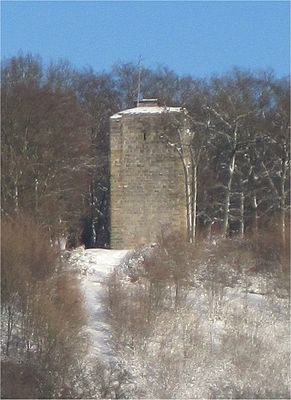Scharfeneck ruins
| Scharfeneck ruins | ||
|---|---|---|
|
Scharfeneck ruins |
||
| Castle type : | Höhenburg, spur location | |
| Conservation status: | Keep | |
| Construction: | Humpback block masonry | |
| Place: | Oberscheinfeld - "Schlossberg" | |
| Geographical location | 49 ° 42 '49.5 " N , 10 ° 26' 40.3" E | |
| Height: | 410 m above sea level NN | |
|
|
||
The Scharfeneck ruin is the ruin of a spur castle northeast of the market town of Oberscheinfeld in the Neustadt an der Aisch-Bad Windsheim district in Middle Franconia . It is located on the Schlossberg, a 425 meter high mountain spur of the Steigerwald . Of the original Scharfeneck Castle, only the 16 meter high keep still exists today , which is maintained as a lookout tower by the Steigerwaldklub Oberscheinfeld .
history
Scharfeneck Castle, known as “Veste Scheinfeld” until the 16th century, was probably founded by a Franconian nobleman named Scego or Skago during the Franconian conquest in the 6th century. The previous castle , of which no remains have been preserved, was demonstrably the seat of the noble Franconian family von Scheinfeld (Sgegevelet 1114, Segevelt 1151, Sheigenvelt 1186), the u. a. the Worms Bishop Leopold II. von Schönfeld (Scheinfeld) came from. Around the year 1201, the Scharfeneck knight Friedrich de Scevelt pledged his property to the Bamberg bishop Timo in order to prepare for the Fourth Crusade (1202-1204). After his death the castle fell to the diocese of Bamberg . In 1339 the castle appeared in the Bamberg castle hat directory when Johann von Dachsbach , Vogt and Knight von Scheinfeld, was awarded a hearth "behind the tower" including vines. After 1366 the castle changed hands several times, including the Bamberg canon Count Albrecht von Wertheim and the knights von Kappel . After the castle had already been described as dilapidated in 1504 ("a dreary castle"), the Bamberg officials demolished around 1545 in order to build a new, more comfortable castle with the stones down in the center of Oberscheinfeld. Only the keep remained as a lookout on the Schlossberg.
Today the keep is accessible on Sundays and public holidays during the summer months.
Building history
On the Schlossberg there is no concrete reference to a castle complex before the 13th century. There is also no trace of the Katharinenkapelle on the Schlossberg, mentioned in 1504. On the mountain spur, separated by two neck ditches , the only remaining remains of the castle is the keep, which today is only a few meters short of its original height of around 20 meters. The massive keep made of humpback blocks dates from the period between 1240 and 1250, as indicated by the shape of the humpback blocks and the design of the tower. With a side length of 7.2 meters and a wall thickness of 2.8 meters, the tower will probably have served as a symbol of power, a refuge and a safe place to keep. It rises above a square floor plan and ends with a viewing platform. The outer walls consist of carefully hewn reed sandstones , which are mainly hunched at the corners. The ornamental arrangement of the differently colored sandstone blocks is striking: while the basic structure of the tower consists of gray sandstone, the corner blocks have beige-yellowish stones. The west wall still contains the original high entrance at a height of 10 meters, which led into a small room with a Romanesque vaulted window chamber. A chimney planned here was obviously no longer implemented. At the end of the 19th century, the tower was made accessible for tourism by breaking a ground-level passage into the masonry and building a 77-step wooden staircase. In 1972/73 these stairs were renewed and reduced to 74 steps. The most recent renovation of the tower was carried out by the Steigerwaldklub, branch association Oberscheinfeld, in the years 1999 to 2001 with a careful addition of stones and repairs to the viewing platform (442.6 m above sea level).
Web links
- House of Bavarian History Bavarian State Ministry for Science, Research and Art, Munich [1]
literature
- Constantin Höfler: Friedrichs von Hohenlohe legal book (1348) . Bamberg 1852.
- Constantin Höfler: Registrum Burghutariorum Ecclesiae Bambergensis . Bamberg 1855.
- Max Bernhard Schwab: Oberscheinfeld and the Scharfeneck castle ruins . In: The village linden . Local history and entertaining supplement to the Scheinfelder Kurier, 2nd year, No. 1–5, 1925.
- Hansjoseph Maierhöfer Oberscheinfeld - Exquisite and experienced . In: The Steigerwald . Journal of a Franconian Landscape, Volume 4, No. 3, 1984.
- Hansjoseph Maierhöfer, Isolde Maierhöfer: The past and the tried and tested In: The Steigerwald . Journal of a Franconian Landscape, Volume 6, No. 3, 1986.



